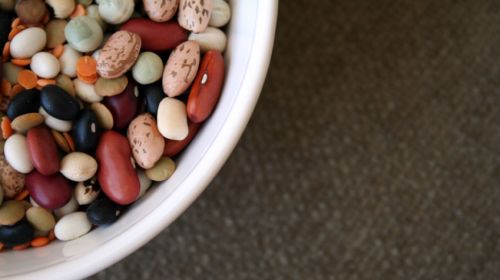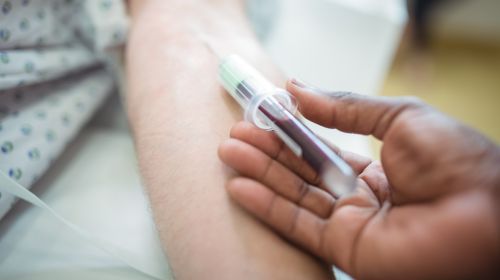People with diabetes mellitus in particular need to measure their blood sugar regularly. The value indicates how high the glucose content is in the blood. You can find out how blood sugar is measured and when it is too high in the table!
- © Getty Images/AaronAmat
Quick overview: Frequently asked questions and answers
What is a normal blood sugar level? Normally, fasting blood sugar is between 70 and 100 mg/dL (3.9 and 5.6 mmol/L) and less than 140 mg/DL (7.8 mmol/L) two hours after meals.
Is high blood sugar dangerous? Chronic elevated levels can damage the blood vessels and lead to serious health problems. Arteriosclerosis, stroke or loss of vision are possible. Tissue damage (like a diabetic foot) is also possible in the long term.
How to lower blood sugar? Insulin therapy is crucial for people with diabetes. In addition, a balanced diet that is high in fiber and low in refined carbohydrates and sugar, regular physical activity, sufficient sleep, good stress management and possible weight loss can help keep levels within the normal range.
At a glance:
What is blood sugar?
The term blood sugar refers to the concentration of glucose in the blood. Glucose is a simple sugar (dextrose) and serves the body as an energy supplier for many metabolic processes.
The body must constantly regulate the glucose content of the blood, as both hypoglycemia and high blood sugar levels can cause damage. Blood sugar levels are regulated by the hormones insulin and glucagon. Insulin lowers the value, glucagon increases it.
Regulation of sugar metabolism
Even in healthy people, glucose levels fluctuate significantly throughout the day. It depends on the meals and how much sugar and/or carbohydrates they contain. It’s completely normal for blood sugar to rise after eating – especially if the meal (or drink) was sweet.
As a result, the pancreas secretes more insulin
- to process the glucose,
- to lower blood sugar levels and
- to bring it back to normal.
This circuit (blood sugar curve) works well in healthy people, but is disrupted in people with diabetes mellitus.
Blood sugar increased due to diabetes
While in type 1 diabetes not enough or no insulin is produced, the body’s own insulin is no longer properly effective in type 2 diabetes.
If left unchecked, blood sugar will remain elevated after eating, especially sweet or carbohydrate-rich foods. This can be done with medication, injections and/or consciously avoiding certain foods.
When is blood sugar measured?
The blood sugar level is determined very often, for example:
Preventive examinations (Check-up 35)
Pregnancy to detect gestational diabetes (gestational diabetes) or to monitor therapy if the disease already exists
Symptoms that indicate diabetes mellitus (urinary urgency, thirst, itching, weight loss)
Suspicion of metabolic disorders
possible diseases of the pancreas
If diabetes is diagnosed, blood sugar is regularly used for monitoring and therapy. However, since the sugar value is only a snapshot, the HbA1c value is now primarily determined for long-term control of diabetes mellitus. It acts as a blood sugar memory and provides information about the average blood sugar level over the last six to twelve weeks.
Diabetes in pregnancy
In pregnant women with diabetes mellitus, glucose levels should be checked consistently and regularly. Due to the change in the hormonal balance and the changed metabolism, the blood sugar level is subject to fluctuations during this time. A value that is too high can have a negative impact on the health of the fetus. There is a risk of organ malformations and development and growth disorders of the embryo.
In addition, a high glucose level in the pregnant woman increases the risk that the child will become overweight at an early age or become diabetic later on.
How is blood sugar measured?
The value is determined either from the blood plasma or from the capillary blood. This allows you to determine whether blood sugar is too high, normal or too low. Depending on the procedure, the results may vary slightly.
People with diabetes mellitus can and should check their blood sugar levels regularly. There are various blood glucose measuring devices available to you. You can also have the value determined easily in pharmacies.
To do this, you usually prick the very end of your finger with a special lancet (needle) or lancing device. The drop of blood is placed on a test strip, which is located in the device for measuring blood sugar.
Measure blood sugar without piercing
Alternatives such as continuous glucose monitoring (CGM) are now available, which can make everyday life easier for those affected.
A fine sensor is inserted into the subcutaneous fatty tissue, which constantly monitors the sugar level. Depending on the method, the measured data can be sent to an app on the smartphone or a so-called real-time measuring device (rtCGM). Depending on the system, the sensor usually needs to be changed after six to ten days.
Measurement of blood sugar from blood plasma
Self-measurement is not a suitable method for diagnosing diabetes mellitus. For this purpose, values from the blood plasma must be determined. To do this, a small amount of blood is taken in a medical practice and evaluated in the laboratory.
In addition, the concentration of glucose in the urine can also be determined. The body’s ability to process glucose can also be determined using the oral glucose tolerance test (OGTT).
Table: How high can blood sugar be?
Blood sugar can be expressed in two different units: milligrams per deciliter (mg/dl) or millimoles per liter (mmol/l).
When measuring, fasting blood sugar (fasting glucose) plays an important role. It provides information about the glucose content in the blood after eight to twelve hours of fasting and should ideally be measured in the morning.
If blood sugar levels are elevated, you have prediabetes, a precursor to type 2 diabetes. In many cases, diabetes can be prevented at this stage by making lifestyle adjustments.
| Normal values | increased value / prediabetes | diabetes | |
| Fasting blood sugar | below 100 mg/dl or below 5.6 mmol/l | 100 to 125 mg/dl or 5.6 to 7.0 mmol/l | higher than 126 mg/dl or 7.0 mmol/l |
| blood sugar two hours after eating | below 140 or below 7.8 | 140 to 200 mg/dl or 7.8 to 11.1 mmol/l | over 200 mg/dl or over 11.1 mmol/l |
Important: The measured value only represents a snapshot. It should also be noted that when measuring the sugar content in blood plasma, the values are around 10 to 15 percent lower than those in capillary blood.
Health dangers from high blood sugar
If levels are elevated, symptoms such as intense thirst, increased urination and vision problems are possible. In extreme cases, there is also a risk of a diabetic coma, which can be life-threatening.
People with known diabetes in particular need to have their blood sugar well under control. Long-term elevated levels can increase the risk of various health complications. These include, among others:
Blood sugar too high or too low: Possible causes
The most common reason for high blood sugar is diabetes mellitus. Other possible causes are:
Gestational diabetes
Pancreatic diseases (pancreatic cancer, pancreatitis)
Hormonal and metabolic disorders
emotional and physical stress
certain medications (e.g. glucocorticoids, which are used to treat various inflammatory or allergic diseases)
Causes of low blood sugar levels
Low glucose levels are often the result of diabetes treatment. The medications taken lower blood sugar levels, and an overdose of insulin is also possible.
In addition, pancreatic or liver diseases as well as heart failure, among other things, can lead to low values.


